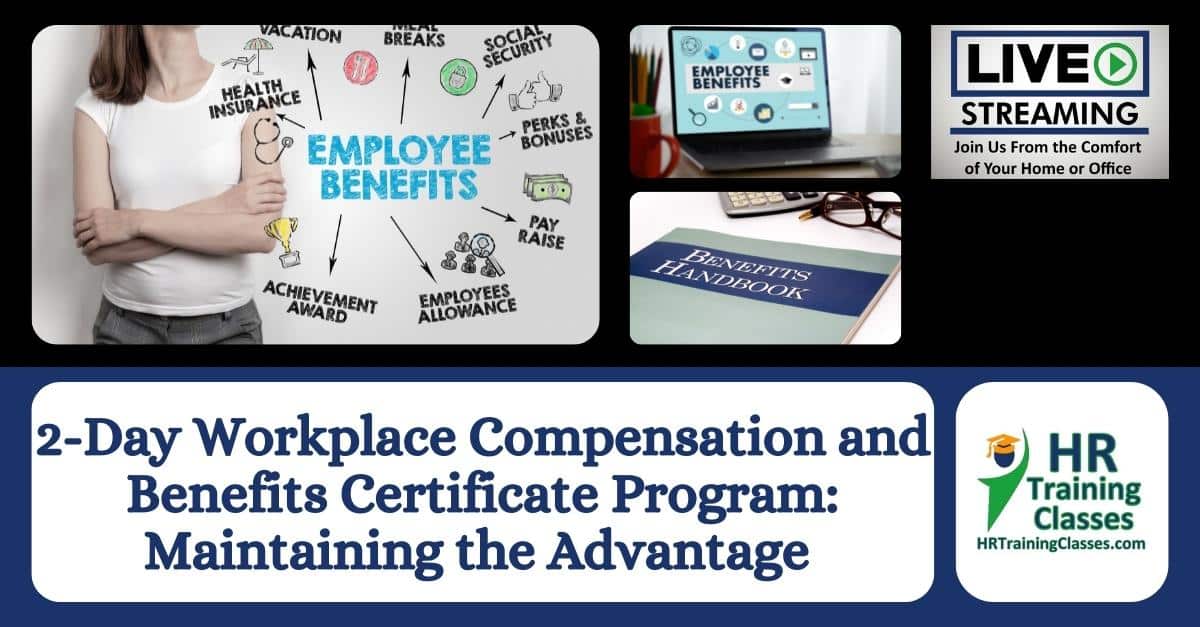

HRCI – 15 HR(General) Credits
SHRM – 15 PDC’s
Every organization, large and small, must determine the pay structure for its employees. Compensation and Benefits administrators are the key specialists in charge of managing the impact of compensation and benefits packages on an organization’s bottom line while ensuring fair and equitable pay rates for employees.
Get the training you need to stay ahead of other organizations in attracting and retaining top talent. It is essential to make employees feel that they are paid fairly and treated fairly for what they do. This is why it is imperative to get Compensation and Benefits aligned with the organization’s vision and goals.
This program provides the fundamental strategic choices that employers must take in creating, designing, developing, & implementing a total reward’s package.
You will learn how to professionally handle questions from staff members at a much higher and qualified level by gaining confidence through the knowledge of the following:
Keeping your employee Compensation & Benefit training current has many rewards. This course will make you and your team more aware of the “Why’s” and “How’s” in creating a staff with more awareness, engagement, & more understanding. Remember, a well-trained Compensation & Benefits employee is in high demand. Being able to anticipate the major trends in employee benefits and how it can improve your retention rates and time-to-fill rates will immensely help your team. Learning how to be more current in laws and policies that are forever changing can also assist you and your team be more prosperous and able to complete projects on time.
Additionally, for HR Professionals understanding the needs and wants of your organization’s employees and aligning them with the executive team’s vision will make specific processes and procedures more efficient and successful. This new knowledge that you will gain through this course will also be vital for you to gain a seat at the strategic table.
Other important strategies that you will learn through this course is as follows:
Don’t forget, during this seminar, there will be periodic quizzes for you to test your knowledge and activities for you to share your thoughts and concerns. Now get ready and enroll because it’s time to expand your Compensation & Benefit knowledge.
Schedule
Day 1
9:00 am – 6:00 pm (Central Time)
Day 2
9:00 am – 6:00 pm (Central Time)
TOPICS:
History Of Benefits (1636 to present)
Then and Now (1636 to present)
Regulatory Benefits
Government Influence on Employee Benefits
Legislation
Regulatory and Judicial Processes
Federal Governing Agencies
IRS – Internal Revenue Service
DOL – Department of Labor
EBSA – Employee Benefits Security Administration
PBGC – Pension Benefit Guarantee Corporation
EEOC – Equal Employment Opportunity Commission
SEC – Security and Exchange Commission
Government Programs
Equal Opportunity Laws
Mandated Employee Benefits
Social Security
Worker’s Compensation
Unemployment
Retirement Plans
Retirement Benefits
Retirement Emotional Journey
ERISA – Employee Retirement Income Security Act
ERISA Provisions
ERISA Section 404C
Pension Protection Act of 2006
QDRO – Qualified Domestic Relations Order
ADP/ACP Non-Discrimination Tests
EGTRRA – Economic Growth & Tax Relief Reconciliation Act of 2001
IRC – Internal Revenue Code of 1926
FICA – Federal Insurance Contribution Act Tax
Plan types and Qualifications
Qualified Compensation (PBGC)
Defined Benefits (Non-Contributory)
SOX – Sarbanes Oxley Act
Traditional Pension
Flat Dollar
Final Pay
Guaranteed income annuities (GIAs)
The Federal Thrift Savings Plan
Cash-Balance Plan
Cash-Value Insurance Plan
Defined Contributions (Contributory)
401k
Solo 401k
403B
457B
IRA
ROTH IRA
Self-Directed IRA
SEP IRA 408k
SIMPLE IRA
Keogh (HR-10)
Plan Distributions
Withdrawal Regulations
Required Distributions
Hardship Distributions
Rollovers
Tax on Early Distribution
Loans from 401(k) plans
Early Retirement Package
Early Withdrawal
IRA Quiz
Non-Qualified Compensation
Deferred Plans
Executive Bonus Plans
Split-Dollar Life Insurance Plans
Rabbi Trust
Top Hat Plan
Health Benefits
ERISA – Employee Retirement Income Security Act
COBRA – Consolidated Omnibus Budget Reconciliation Act
GINA – Genetic Information Non-Discrimination Act
HIPAA – Health Insurance Portability and Accountability Act
ACA – Affordable Care Act
Medicare/Medicaid
Short Term Disability/Long Term Disability
Life Insurance
Dental Care/Vision Care
AD&D – Accidental Death and Dismemberment
Extended or Long-Term Health Care
EAP – Employee Assistance Program
Mental/Behavioral Health Care
Mental Health Parity Act (MHPA)
HMO – Health Maintenance Organization
PPO – Preferred Provider Organization
HDHP – High Deductible Health Plan
Cafeteria Plans
IRC Section 125
IRC Section 129
FSA, HSA, HRA
Self-Funded
Stop/Loss Coverage
Prescription Drug Plans
Health Benefits Quiz
Compensation
Attract & Retain
Compensation Management Process
Major Influences
Internal Equity vs External Equity
Job Analysis Process
Direct Pay
FLSA
Pay Decisions/Strategy
Types of Compensation
Comp Terms
Job Evaluations
Qualitative
Quantitative
Indirect Pay
Stock Options
Equity
Executive Plans
Non-Financials
Performance Benefits
Incentives
Individual
Groups
Organization
Office Perk Benefits
Employee of the Month
Holiday Bonus
Employee Discounts & Rewards
Flex-Time
Care & Recognition Gifts
Employee Development Plans
Wellness Program
Gym Membership
Adulting Classes
Tuition Reimbursement
Office Perks
Child Care Assistance
Commuter Assistance
Legal Assistance
Adoption Assistance
Disaster Relief Assistance
Financial Assistance
Diversity Program
Engagement Committee
Pre-Tax Limitations
Reimbursements/Allowances
Time Off Benefits
FMLA
USERRA
Holiday/Vacation/Sick Days/PTO
Bereavement Leave
Jury Duty Leave
Voting Time Leave
Sabbatical/Personal Leave
Paid Parental Leave
Covid Sick Leave
Benefits Design Strategy Aligning With HR & Business Goals
Strategic Assessment
Conduct a GAP Analysis
Costing & Pricing
Select & Design
Funding & Approval
Implement
Train & Monitor
Open Enrollment
High Level Open Enrollment Calendar
Compliance Calendar Example
Communication Strategy Fundamentals
Select the Communication Style
Potential Barriers to Communication
Fundamentals
Communication Models
Effective Communication
Potential Barriers
Filtering
Selective Perception
Information Overload
Emotional Disconnect
Workplace Gossip
Semantics
Gender Differences
Sender/Receiver Differences
Biased Language
Communicating the Value
Compensation/Reward Statement
Outsourcing Strategy
Analysis
Budget
Create Request for Proposal
Send Request for Proposal
Choose Contractor
Negotiate
Implement
Evaluate/Manage
Certification Process